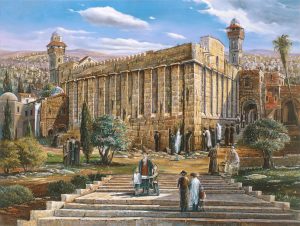Vayishlach 2019: Real Estate 1.1
by devadmin | December 12, 2019 7:44 pm
Just as the Oisvorfer was hanging up his coat in the shul’s overcrowded coatroom this past shabbis, his weekend guest asked if I could name the three parcels of land recorded in the heylige Toirah and or in Tanach which were purchased for cash mamish. Nu, in the few seconds we had before entering the sanctuary, we agreed on all three. And with that question from chaver Elliot Ostro, the idea of writing about at least one of them began germinating; here we go.
Who was the first Jewish person to dabble in real estate? What was purchased and where? Let’s find out. Several weeks ago, back in parsha Chaya Soro, we learned that Avrohom Ovenu purchased a piece of land with a building of sorts on it making him the first Jew ever to deal in the real estate market. Though he negotiated against himself by insisting on paying full value when the land was offered to him –more than once, and free of charge mamish- as history would prove, he made the right decision and a good buy. For thousands of years since, whenever politically possible, tens and mistama hundreds of thousands of Yiddin along with goyim –our cousin’s mamish- and others, make it their business to visit the city of Chevroin where Avrohom buried his wife Soro. As it turns out, the RBSO had seemingly used this very land and cave to bury Odom and Chava –a coincidence mamish!? In later years, other forefathers and foremothers were also interred there. And so –according to some- was Eisav’s head. As to the rest of Eisav, ver veyst, and that topic for another day. Land values have never gone down in Chevron. Ober, even since its purchase, the sellers have had what we call sellers-remorse and have tried to invalidate the transaction. Over the ensuing years, many hundreds have died defending the land and the Meoras Hamachpela which sits on it. Despite the violence and controversy, the value of this shtikel real estate continues to go up and is today among the priciest pieces in all of Israel, and efsher the world. Is there a better place to have the heylige Toirah come to life? Not! It’s Chevron!
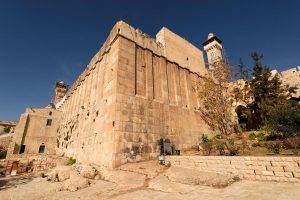 And the second purchase? Nu, it skipped a generation as it appears that while his father was a shtikel land owner –seemingly also of the first ever cemetery- Yitzchok never bought land. He did dig wells looking for water ober the ownership of most was also disputed by the Plishtim (we should have known then…). He did eventually dig one which was not disputed, was able to claim it as his without dispute. He named it Richovos (Rechovot).
And the second purchase? Nu, it skipped a generation as it appears that while his father was a shtikel land owner –seemingly also of the first ever cemetery- Yitzchok never bought land. He did dig wells looking for water ober the ownership of most was also disputed by the Plishtim (we should have known then…). He did eventually dig one which was not disputed, was able to claim it as his without dispute. He named it Richovos (Rechovot).
Ober this week’s parsha and the next few, feature the adventures of Yaakov and his family and if you thought for even a moment that the homes of our forefathers Avrohom and Yitzchok, were at least partially dysfunctional (they zicher were, ober the RBSO loved them and selected them despite those conditions), wait until you read of the incredible chaos that reigned in the Yaakov Ovenu household. Parshas Vayishlach contains, among several very interesting storylines (all of which have been covered by the heylige Oisvorfer in earlier postings over the past nine years –we are in year ten and feel free to check them out at www.oisvorfer.com) something unique: a family reconciliation. Eisav and Yaakov make peace after some fourteen years of death threats and more. One can imagine that they did not attend each others simchas during that period of time. The emes is that fourteen years is nothing; nowadays, we come across brothers and other family members not talking for decades. It also features the famous rape of Yaakov’s only daughter Dina. According to one medrish, prior to that incident, Yaakov had hid Dinah in a box to prevent Eisav from eyeing her. He, according to the medrish (Medrish Rabbah) thought to himself azoy: would Eisav but see her, he would insist on marrying her. Ober the RBSO rebuked Yaakov’s line of thinking with these words: “If thou hadst married off thy daughter in time she would not have been tempted to sin, and might, moreover, have exerted a beneficial influence upon her husband.” The RBSO, not at all happy with Yaakov’s decision (suggesting that Dina could have had a positive influence on Eisav, arranged –doesn’t He arrange everything- for another stranger to get into Dina’s box, if you chap. As an aside, another medrish suggests that following the ugly abduction and rape myshe (incident), that Dina eventually married Iyov (Job) who will be shouted out a few paragraphs below in this review. The parsha also features a real estate transaction. It does?
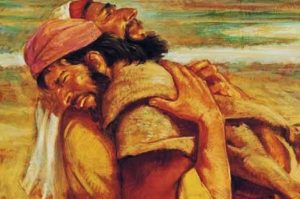 Ober before we cover that transaction and all that took place post ownership, we should know that according to at least one medrish, Dinah would have been just about six years old and Eisav 97 years old at the time Yaakov boxed her in for safekeeping. What? Yet another case of an older Toirah personality chasing after a minor? Let’s recall that Yaakov and Eisav were twins. Yaakov arrived to Lovon’s house at age 77. He stayed 20 years, and shoin, he’s now 97. Dina was born to a much older Yaakov. How would it be at all shayich (remotely possible) for such a young girl to influence a grown man whose personality, attitudes, and actions had already been shaped? After all, his own parents Yitzchok and Rivka could not reign him in, but a young Dina would? What’s taka pshat? And the answer? Ver veyst! The bottom line: it’s a medrish. Did Yaakov really hide Dina in a box? One day when we all come back to life, we can ask Yaakov what went down. Veyter.
Ober before we cover that transaction and all that took place post ownership, we should know that according to at least one medrish, Dinah would have been just about six years old and Eisav 97 years old at the time Yaakov boxed her in for safekeeping. What? Yet another case of an older Toirah personality chasing after a minor? Let’s recall that Yaakov and Eisav were twins. Yaakov arrived to Lovon’s house at age 77. He stayed 20 years, and shoin, he’s now 97. Dina was born to a much older Yaakov. How would it be at all shayich (remotely possible) for such a young girl to influence a grown man whose personality, attitudes, and actions had already been shaped? After all, his own parents Yitzchok and Rivka could not reign him in, but a young Dina would? What’s taka pshat? And the answer? Ver veyst! The bottom line: it’s a medrish. Did Yaakov really hide Dina in a box? One day when we all come back to life, we can ask Yaakov what went down. Veyter.
Yaakov Ovenu, Avrohom’s grandson follows in his zeyda’s footsteps and will also makes a significant purchase. And while Avrohom ended up paying full value, 400 silver coins, it appears that Yaakov ended up buying his land for but 100 kisita. Where did Yaakov buy land? What became of it? Was it ever developed? Was Yaakov the first ever GC (general contractor) and or civil engineer? Was it also a cemetery? Is anyone famous buried there? Was seller’s remorse also exhibited? Which one of our Ovos did the better deal? Let’s find out by reviewing what the heylige Toirah specifically tells us.
Says the heylige Toirah (Bereishis 33:18-20), azoy: Yaakov arrived safe in the city of Shechem which is in the land of Canaan – having come thus from Padan-Aram – and he encamped before the city. The parcel of land where he pitched his tent, he purchased from the children of Chamor, Shechem’s father, for a hundred kesitas. He set up an altar there, and called it El-elohay yisrael. As an aside, Chamor’s son Shechem is the minuvil who raped Dina. Shoin. What the hec is Shechem?
And the answer is azoy: Today it’s known as Nablus, and in Arabic: نابلس , ober back in the days of our forefathers and even in the times of Dovid Hamelech (King David) and others, it was known as the city of Shechem. Many things happened in Shechem ober unlike what happens in Vegas, events that took place in Shechem are well documented in the heylige Toirah and Tanach, and are discussed regularly. Today it’s a dangerous place; back then the city played a pivotal role in Jewish history as many –mostly unpleasant- events unfolded there. Was it cursed? We shall efsher find out.
We read that Yaakov purchased his real estate for 100 kisitas, ober, what were kisitas and how much was each worth? Was the kisita the forerunner to bitcoin? Ver veyst? The bottom line: the Kesita was an ancient biblical form of monetary measurement, it’s value or weight seemingly no longer known. Yaakov paid one hundred pieces of some form of money. Later in Tanach (Iyov 42:11), we find a reference to the kisita money as being a lamb. If this is emes, Yaakov paid for his land in Shechem with 100 lambs, or pieces of lamb. After the RBSO restored his fortunes, Iyov, received a kesita from each of his friends. Lamb chops for all! Subsequently, the kesita was probably a piece of money of a particular weight, cast in the form of a lamb, Let’s get back to real estate and what happened next.
Nu, mistama you have questions and zicher you should. As last week’s parsha was coming to an end, Yaakov and his extended family -and flock- fled Lovon’s house fully intending a return to his own father’s house; he had not seen his parents in over twenty years. And he stopped off in Shechem and decided to dabble in real estate? And to build himself a house? What’s pshat? Exactly why he stopped along the way and instead bought land and built himself a house and also huts (sukkot), is of course hotly debated. The bottom line: we don’t know why; we do know that he stopped and lived in Shechem where he bought property and made other improvements to the city of Shechem. We know this how? From the medrish, where else? If you want more direct information, feel free to ask him that question as well one day. For now, it appears that the Shechem purchase was efsher the beginning of the unraveling of the Yaakov Ovenu household.
What happened next? Our sages of the heylige Gemora (Shabbis) tell us that Yaakov went about making physical improvements to the city for its inhabitants. He became a developer. He also built a mizbayach, an altar, as did his grandfather Avrohom, to thank the RBSO for his good fortune in arriving safely after two dangerous roadside encounters. Recall that as the parsha opens, Eisav was coming towards him with an army of 400 ready for battle. Anticlimactically, the feud ended with a big kiss. And on his way home, he also had a shtikel encounter with his shver (FIL) Lovon who had intended to harm him, ober avada the RBSO had Yaakov’s back. Instead of a harmful encounter Lovon sheepishly left after warning Yaakov not to withhold sexual favors from his daughters. That what I call a good father; he had his daughters backs and fronts, if you chap. As an aside, chaver Meyer Jeger sent over a short meme (pun intended) which read azoy. “Rashi in the Gemora writes that Lovon was only one- and one-half feet tall. Says Toisifs: “that’s a little shver!” Barra beem! If you speak Yiddish that was a great line. If not, too bad!
He became a developer? What did he build? What improvements did Yaakov make to the area and its surrounds? The heylige Toirah does not tell us but others do. Says the heylige Gemora (Shabbis 33b): “Rav said, ‘He created money for them.’ Shmuel said, ‘He established markets for them.’ Rabbi Yoichanan said, ‘He established bathhouses for them.’” Why Yaakov decided to make improvements, ver veyst? Logic dictates that he had planned to, or did live there in or near Shechem for a number of years and took it upon himself to develop the city. Ober, how was he repaid by the Shechehmites for his kindness and largess? Chamor’s son Shechem took a shine to Dina and raped her. Rashi tells us he abused her naturally and also not so, if you chap, which Shechem that minuvil seemingly did. Shoin. Shimon and Levi defended her honor by grabbing their swords -mistama gotten as bar mitzvah gifts (medrish does tell us they were 13 and 14 at the time) and then wiped out all male inhabitants of the city. When was this revenge massacre carried out? Says the heylige Toirah (Bereishis 34:25), azoy.
25. Now it came to pass on the third day, when they were in pain, that Yaakov’s two sons, Shimon and Levi, Dinah’s brothers, each took his sword, and they came upon the city with confidence, and they slew every male. |
כה וַיְהִי֩ בַיּ֨וֹם הַשְּׁלִישִׁ֜י בִּֽהְיוֹתָ֣ם כֹּֽאֲבִ֗ים וַיִּקְח֣וּ שְׁנֵֽי־בְנֵֽי־יַֽ֠עֲקֹ֠ב שִׁמְע֨וֹן וְלֵוִ֜י אֲחֵ֤י דִינָה֙ אִ֣ישׁ חַרְבּ֔וֹ וַיָּבֹ֥אוּ עַל־הָעִ֖יר בֶּ֑טַח וַיַּֽהַרְג֖וּ כָּל־זָכָֽר: |
In plain English: Shimon and Levi somehow knew that the Shechemites would be in a weakened positioned on the third day following the mass bris event. How they knew? We shall address that below. Avada when the heylige Toirah goes out of its way to include this very specific detail -the third day following the mass bris circumcision which Yaakov insisted upon before he would allow his family to marry Shechemites- you can imagine that many an exegete was left wondering why Shimon and Levi decided to take action davka on the third day.
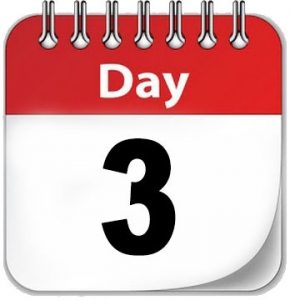 Says Rabaynu Bachya azoy: their third day attack plan was strategic; it had both scientific and astrological rationale and implications. Were Shimon and Levi scientists and or astronomers? At bar mitzvah age? Shoin, whether they were or not, here’s what he says. It is an accepted fact in science that amongst all creatures, the “third” is always relatively weak. It makes no difference whether it’s the third day after a woman has given birth, or whether it is a third day in the development of anything else. And why is that? It’s due to the fact that the third day is under the aegis of planet Mars. This is why the pain after a wound has been inflicted, is always greater on third day. This is why the pain of circumcision is greatest on the third day, weakening the person who has undergone the procedure. Our sages in the heylige Gemora (Shabbis 86) have accordingly ruled that it is permissible to perform all kinds of procedures otherwise prohibited on the Shabbis for a person on the third day after he has been circumcised. Why? Because he is weak, even his life may be in some danger.”
Says Rabaynu Bachya azoy: their third day attack plan was strategic; it had both scientific and astrological rationale and implications. Were Shimon and Levi scientists and or astronomers? At bar mitzvah age? Shoin, whether they were or not, here’s what he says. It is an accepted fact in science that amongst all creatures, the “third” is always relatively weak. It makes no difference whether it’s the third day after a woman has given birth, or whether it is a third day in the development of anything else. And why is that? It’s due to the fact that the third day is under the aegis of planet Mars. This is why the pain after a wound has been inflicted, is always greater on third day. This is why the pain of circumcision is greatest on the third day, weakening the person who has undergone the procedure. Our sages in the heylige Gemora (Shabbis 86) have accordingly ruled that it is permissible to perform all kinds of procedures otherwise prohibited on the Shabbis for a person on the third day after he has been circumcised. Why? Because he is weak, even his life may be in some danger.”
Experts of the science known as Techunah, a form of astronomy, wrote that the third day is under the influence of the horoscope ‘cancer’ which in turn is presided over by Samael. This Samael is not a good guy and Samael’s personal servant is the planet Mars. What that all means, ver veyst, ober the bottom line is this: Shimon and Levi took advantage of their weakened state and shoin, they killed all the males.
Says the medrish (Yalkut) back in parshas Lech Lecha when recounting the bris of Avrohom Ovenu at the age of 99 that the pain of circumcision is very Bad on the third day. Astrologers tell us that the third day (of anything) causes weakness to a man. This includes Tuesday’s, the third day of the week. And says the Yalkut, seemingly also an astronomer of sorts, azoy: the third day is dominated by the sign of Scorpio, its anger is Samael -he’s back- and its planet is Mars. The bottom line: the Shechemites were seemingly weak on the third day and Yaakov’s boys struck.
And then? They seemingly also took control of the rest of the city. All hell broke loose. Says the medrish: Yaakov rebuked his sons for their killing spree. Soon after, a large army of Canaanites gathered to fight Yaakov and his sons, ober the RBSO had his back. Why? Because both Yaakov and his father Yitzchok davened to the RBSO, the Canaanite kings became frightened and resolved to return to their cities without a fight. Davening, so says the medrish, helps. Mamish a neys-min-hashomayim (a miracle form heaven). And then? The medrish continues: Yaakov moved to Chevron where his father Yitzchok lived. There he resided many years. Another medrish tells us that seven years later, Yaakov returned to Shechem because the land was best suited for his large flocks. Says the Oisvorfer: let’s not forget that Yaakov left in a hurry and mistama before he could sell his land and therefore returned to check on his real estate investment. Again, the kings of Canaan united (seven of them) to destroy the children of Israel. But with the help of the RBSO and under the heroic leadership of Yehudah, the small army, composed of Yaakov’s sons and servants, defeated the kings who had united against them. The rest of the Canaanite kings were now afraid of Yaakov’s sons, they preferred to make peace. Once again Yaakov returned to Chevron, but his sons stayed with the herds near Shechem. And then?
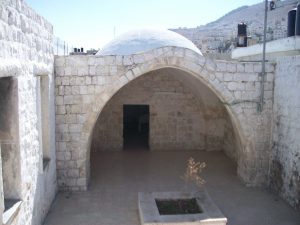 Years later, while living in far-away Chevroin , Yaakov –as we will learn mamish next week- sent his sons to graze his sheep back in Shechem -presumably because he still owned pasture land there. Subsequently he sent his beloved son Yoisef to check on the brothers. Yoisef obeyed his father, but once he found them, he became the victim of their hatred and found himself sold into slavery to Mitzrayim (Bereishis 37:12-28). That saga unfolds in next week’s parsha, and continues until the end of Sefer Bereishis. Yoisef somehow survived years in jail, and many years later, and already installed as viceroy of Egypt, his father, together with all of his family joined him in Mitzrayim. On his deathbed (Bereishis 48:21-22), Yaakov blessed Yoisef by giving him “one portion over your brothers.” Rashi interprets this phrase to mean that Yaakov assigned the deed of his Shechem holdings to Yoisef and his descendants. Centuries later, in the time of Yihoishua (Joshua), the parcel of land is revisited: Yoisef was buried on this very land where the Tomb of Yoisef remains ad hayoim hazeh (to this day). Says the Novee (Yihoishua 24:32): The bones of Yoisef, which the Israelites had brought up from Mitzrayim were buried at Shechem, in the parcel of land which Yaakov had bought for a hundred kesitas from the children of Chamor, Shechem’s father, and which had become a heritage of the Josephites. Note how the text describes Joseph’s burial site: It is known, first and foremost, as the “parcel of land” that Jacob purchased, to which the people of Israel later added Joseph’s remains. Sadly, that site has been the scene of many disturbances by today’s Palestinians; Yoisef’s tomb has been disturbed at least several times in the past 25 years.
Years later, while living in far-away Chevroin , Yaakov –as we will learn mamish next week- sent his sons to graze his sheep back in Shechem -presumably because he still owned pasture land there. Subsequently he sent his beloved son Yoisef to check on the brothers. Yoisef obeyed his father, but once he found them, he became the victim of their hatred and found himself sold into slavery to Mitzrayim (Bereishis 37:12-28). That saga unfolds in next week’s parsha, and continues until the end of Sefer Bereishis. Yoisef somehow survived years in jail, and many years later, and already installed as viceroy of Egypt, his father, together with all of his family joined him in Mitzrayim. On his deathbed (Bereishis 48:21-22), Yaakov blessed Yoisef by giving him “one portion over your brothers.” Rashi interprets this phrase to mean that Yaakov assigned the deed of his Shechem holdings to Yoisef and his descendants. Centuries later, in the time of Yihoishua (Joshua), the parcel of land is revisited: Yoisef was buried on this very land where the Tomb of Yoisef remains ad hayoim hazeh (to this day). Says the Novee (Yihoishua 24:32): The bones of Yoisef, which the Israelites had brought up from Mitzrayim were buried at Shechem, in the parcel of land which Yaakov had bought for a hundred kesitas from the children of Chamor, Shechem’s father, and which had become a heritage of the Josephites. Note how the text describes Joseph’s burial site: It is known, first and foremost, as the “parcel of land” that Jacob purchased, to which the people of Israel later added Joseph’s remains. Sadly, that site has been the scene of many disturbances by today’s Palestinians; Yoisef’s tomb has been disturbed at least several times in the past 25 years.
The bottom line: Shechem turned out to be a bad place with bad luck in the air. Whatever Yaakov’s plans were with regard to Shechem upon his arrival, the RBSO had other ones. Yaakov’s were foiled by unexpected events. Yaakov left Shechem in a hurry but did return later on. On his deathbed, Yaakov bequeathed his lone real estate holding in Shechem over to his favorite son Yoisef. That gift proved valuable as Yoisef was himself buried there. In the end, Both Avrohom and Yaakov owned land which was used to bury another member of the family. This may explain the occasional negative references to the city found in the heylige Gemora. Says the heylige Gemora (Sanhedrin 102a) and we quote, azoy: it was taught in the name or Reb Yosi: Shechem is a place ordained for calamity. In Shechem, they tormented and raped Dina, in the outskirts of Shechem, the -no so heylige- brothers sold Yoisef, in Shechem, the kingdom of the house of David was divided. Our sages tell us that the roads leading through Shechem were ritually impure. The heylige shevotim (tribes) sinned there seemingly more than once. Let’s recall how they took it upon themselves to kill all Shechemite males.
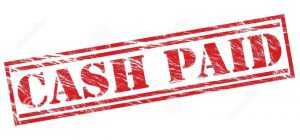 Another bottom line: Shechem, or at least a part of it, was purchased for some form of currency, as was the Meoras Hamachpaylo over in Chevroin. And the third area so purchased? Says the medrish (Medrish Rabbah 79:7): Reb Yudan bar R’ Simone said. This parcel (Shechem) of land is one of three places in regard to which the nations of the world were unable to castigate the Jewish people by saying, “they are in your possession by theft.” And these are the three: the cave of the Machpaylo, the Temple, and the grave of Yoisef. We already mentioned the parcels in Chevroin and in Shechem, ober which Temple was purchased for cash?
Another bottom line: Shechem, or at least a part of it, was purchased for some form of currency, as was the Meoras Hamachpaylo over in Chevroin. And the third area so purchased? Says the medrish (Medrish Rabbah 79:7): Reb Yudan bar R’ Simone said. This parcel (Shechem) of land is one of three places in regard to which the nations of the world were unable to castigate the Jewish people by saying, “they are in your possession by theft.” And these are the three: the cave of the Machpaylo, the Temple, and the grave of Yoisef. We already mentioned the parcels in Chevroin and in Shechem, ober which Temple was purchased for cash?
Let’s close with a few lines from 1 Chronicles 21:22-30: David said to Ornan, “Give me the site of the threshing floor, so that I may build an altar to Hashem in it. Give it to me for the full price, so that the plague will cease from the people.” But Ornan said to David, “Take [it] for yourself, and let my lord the king do whatever is proper in his eyes. See, I have given you the cattle for burnt-offerings, the threshing tools for firewood, and the wheat for a meal-offering – I have given everything!” But King David said to Ornan, “No; I shall buy it for the full price, for I shall not offer to Hashem that which is yours, nor offer up a free burnt-offering!” So David gave Ornan for the place gold shekels weighing six hundred. David then built an altar there to Hashem, and he offered burnt-offering and peace-offerings. He called out to Hashem, and He responded to him with fire from heaven upon the Altar of burnt-offering. Hashem then said [the command] to the angel, and he returned his sword to its sheath. At that time, when David saw that Hashem had answered him at the threshing floor of Ornan the Jebusite, he brought offerings there. The Tabernacle of Hashem, which Moses had made in the Wilderness, and the Altar of Burnt-offering, were at the High Place in Gibeon at that time, but David could not go before it to seek God, for he was terrified before the sword of the angel of Hashem. Did that prevent seller’s remorse? Not! Three bona fide purchases and fights for generations over all three. Mistama it’s all part of the RBSO’s master plan which will also be revealed one day, hopefully soon.
A gittin Shabbis-
The Heylige Oisvorfer Ruv
Yitz Grossman
Source URL: https://oisvorfer.com/vayishlach-2019-real-estate-1-1/
